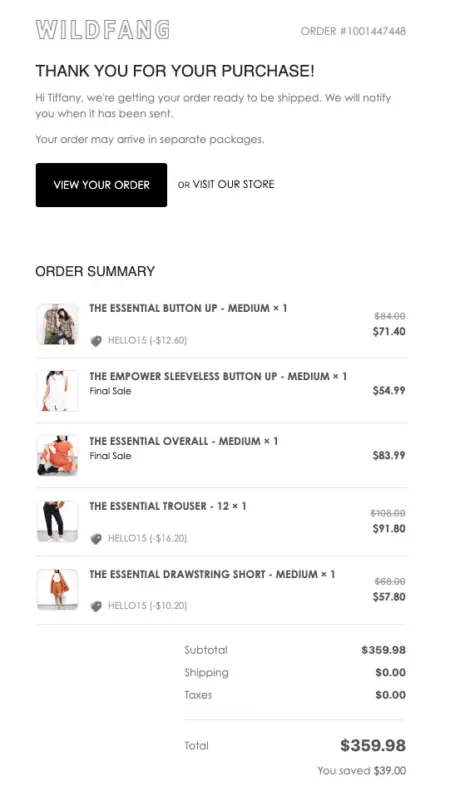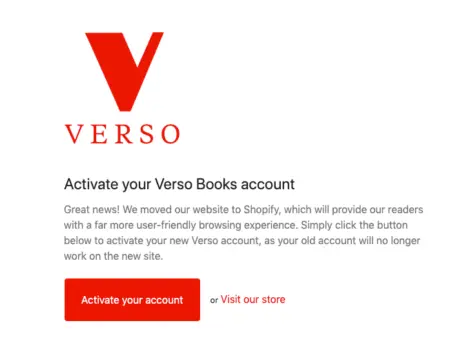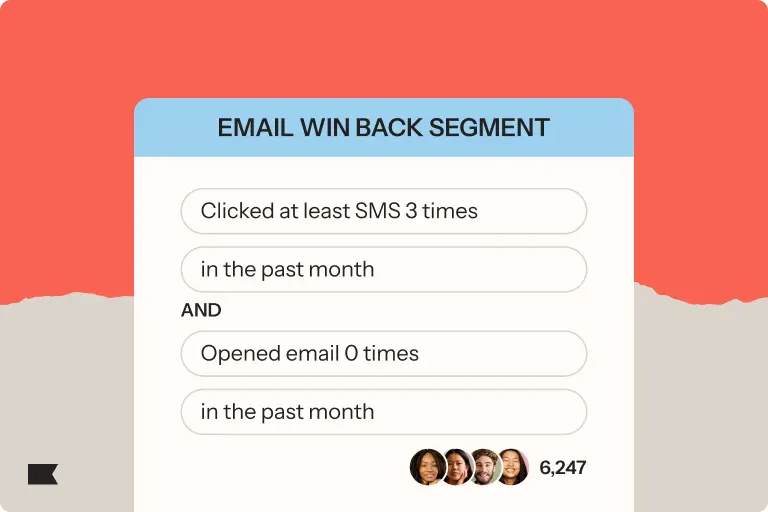4 successful transactional email examples: clarity wins every time

How do you know you’re getting the most out of your transactional emails?
You might understand transactional emails basics and some general transactional email best practices to make sure they’re compliant and well executed.
But are you able to easily personalize your transactional emails using multiple data sources, such as pulling in the customer’s unique number of loyalty points? Are you able to strategically time your other communications to align with your transactional flows, such as triggering a review request flow only after the customer has received a delivery confirmation?
Compass Coffee didn’t realize what they were missing out on until they moved their reviews program to Klaviyo. With their old reviews solution, the automated review request email went out a fixed number of days after an order was placed—and there was no way to customize the experience for delayed or lost orders.
“You’d get the out-of-the-box review request and referral flows, but you couldn’t set all the rules and filters and triggers that you can with Klaviyo,” recalls Compass CMO Joel Shetterly.
After switching to Klaviyo Reviews, the DC-based coffee brand’s review request flow immediately worked better. In Klaviyo, they can now customize the trigger for their review request flow, so it only goes out after the customer receives an order confirmation email.
“Klaviyo wins on the customizability of the review collection correspondence,” Shetterly says. “The rate of review collection is completely solved.”
To get the most out of transactional emails, it’s crucial to think about not just transactional email basics and best practices, but also how and where transactional emails fit into your larger marketing ecosystem—and whether your current technology is streamlining all of it as efficiently as possible.
Here, we take a look at a few transactional email examples to give you a feel for what’s possible when you have the right marketing platform on your side, as well as a best practices refresher for maintaining high email deliverability.
1. Wildfang’s order confirmation sets expectations
Order confirmation emails serve several purposes:
- They acknowledge the purchase is complete and assure the customer it’s legit.
- They set expectations about shipping and receipt.
- They create excitement and reinforce the decision to purchase.
This example from queer apparel brand Wildfang masters all 3 of those goals. The email itemizes each piece of clothing and says everything is ready to be shipped—while setting the expectation that items may arrive in separate packages.

Image source: Wildfang
The customer can also see which items are final sale and which items they saved money on with a discount code. The total amount of savings is the last little piece of flair that makes the customer feel special.
2. Wildfang’s return confirmation makes exchanges easy
Returns are never what you want to happen, but they always will—so you want to make the experience of returning an item as easy as possible. This will make it more likely that a customer will either just request an exchange or buy again after they’ve returned an item.
Your goals for your order return confirmations are to:
- Include paid postage and instructions for the return.
- Clarify next steps for an exchange.
- Clarify next steps for a full refund.
- Make it easy for the customer to speak with customer service if they need to.
Let’s return to Wildfang for another great transactional email example In this return confirmation, the brand makes it easy, and free, to return an item after the request has been made.

Image source: Wildfang
In this case, the return was made because an item was the wrong size, not because the customer was unhappy with her order. The digital gift card for store credit was issued automatically, making it easy to get the correct size and preserve the original sale.
3. Verso Books’ account activation email shows they care about brand experience
Account notification or activation emails serve several purposes:
- They make the account holder feel like their data is secure.
- They set expectations for website experience.
- They create excitement about membership.
This example from Verso Books does a great job showing account holders that the brand cares about their experience. Here, Verso communicates a move to Shopify, which requires the user to activate a new account—and explains that if they do so, they can expect a more user-friendly browsing experience.

Image source: Verso Books
The email also clearly but concisely explains why Verso decided to make the move, which encourages people to come along with them.
4. OSEA’s shipping confirmation offers transparency
Shipping confirmation emails serve several purposes:
- They assure the customer their order is on the way.
- They set expectations for when the order is expected to arrive.
- They empower the customer to track their shipment with a tracking link.
This example from vegan skincare brand OSEA hits all 3 notes. The box at the top of the email is a nice design touch, too, as it makes it easy for recipients to track their package.

Image source: OSEA
Best practices refresher: how to preserve and improve email deliverability
Transactional emails are so essential that even regulators agree they’re necessary for the baseline operations of your business.
But what happens when such crucial emails end up in junk folders? Your customers think their order didn’t go through—or, worse, that your business isn’t legitimate.
This is why improving your email deliverability to fight against the dreaded spam folder vortex is so important for your brand. Here’s a quick refresher on how to do it, but check out our article on transactional email best practices for the full details:
- Use a unique sender address specifically created for sending emails from your brand’s online store.
- Use clear subject lines that are specific to your message.
- Keep email copy brief and straightforward.
- Make sure your transactional emails look and sound like they come from your brand.
- Include your social media links in the footer.
- Include one link to a helpful and relevant product guide.
- Include user-generated content (UGC) showcasing how other shoppers styled or used the product the customer ordered.
- Notify customers of brick-and-mortar locations near them.
- Add relevant product recommendations to a shipment confirmation email.
Klaviyo integrations open new opportunities for transactional emails
The types of transactional emails you configure in Klaviyo will depend in large part on your integrations.
Remember the Compass Coffee example? In Klaviyo, different integrations bring over different events (or metrics), which can, in turn, be used to trigger different types of flows. For many pre-built integrations, order and shipping confirmation emails are the transactional emails you can configure out of the box.
We recommend reviewing the data for your specific integrations to see which types of transactional emails you can leverage out of the box. To configure other types of transactional emails, use Klaviyo’s open API.
Related content

Related content

Discover the best email marketing platform for ecommerce in 2026. Compare top tools for data, automation, personalization, and deliverability.

Learn how to use Klaviyo SMS, segmentation, and hybrid flows to re-engage lapsed email subscribers, boost deliverability, and drive higher retention.

Boost D2C email revenue from 12% to 30% with the Klaviyo playbook: high-converting pop-ups, a 5-email welcome series, smart filters, and optimized abandonment flows.